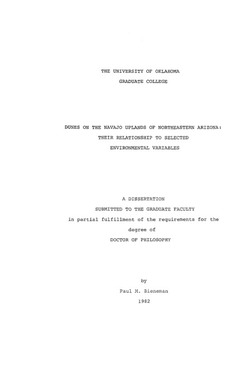| dc.contributor.author | Bieneman, Paul M., | en_US |
| dc.date.accessioned | 2013-08-16T12:28:34Z | |
| dc.date.available | 2013-08-16T12:28:34Z | |
| dc.date.issued | 1982 | en_US |
| dc.identifier.uri | https://hdl.handle.net/11244/4993 | |
| dc.description.abstract | The study area is characterized by nearly horizontal, sedimentary, eolian, sandstone formations with scattered areas of shale. The climate is semi-arid and landforms consist primarily of broad open valleys. A variety of dune types are present, however longitudinal dunes tend to be most common. The area is included almost entirely within the Navajo Reservation where overgrazing has contributed to the destruction of vegetation and the development of dunes. | en_US |
| dc.description.abstract | Factor scores from significant variables were used in the classification portion of the discriminant analysis routine and produced the model. The model was tested on 100 new sites to determine its classification ability. Factor scores from the 100 "new" sites were classified according to the model developed on the 100 "original" sites. Of the 18 sites classified as belonging to the group dune, 16 were actual dunes. Sixty-nine of the 82 member non-dune group were correctly classified. | en_US |
| dc.description.abstract | Investigation of the selected geomorphic, meteorologic, and lithologic variables and the occurrence of dunes on the Navajo Uplands of Northeastern Arizona yielded a number of interesting insights into the relationship between dunes and the environment responsible for their existence. | en_US |
| dc.description.abstract | Fifteen variables were selected as possible indicators of dune occurrence. Analysis of the variables by the hypothesis testing portion of the discriminant analysis routine determined the relationship between means of the dune and non-dune group and the discriminating power of each of the variables. Those variables whose means were not significantly different were rejected from further consideration. | en_US |
| dc.description.abstract | As a result of the analysis, it was possible to predict dune prone areas within the study area based upon the physical environmental attributes of specific sites. | en_US |
| dc.description.abstract | The 12 significant variables were subjected to factor analysis to determine the relationships between the variables and to produce the independent factor scores necessary for the model development. Four factors were discernable. | en_US |
| dc.format.extent | 149 leaves : | en_US |
| dc.subject | Physical Geography. | en_US |
| dc.title | Dunes on the Navajo Uplands of Northeastern Arizona : | en_US |
| dc.type | Thesis | en_US |
| dc.thesis.degree | Ph.D. | en_US |
| dc.thesis.degreeDiscipline | Department of Geography and Environmental Sustainability | en_US |
| dc.note | Source: Dissertation Abstracts International, Volume: 43-05, Section: B, page: 1412. | en_US |
| ou.identifier | (UMI)AAI8224186 | en_US |
| ou.group | College of Atmospheric & Geographic Sciences::Department of Geography and Environmental Sustainability | |
